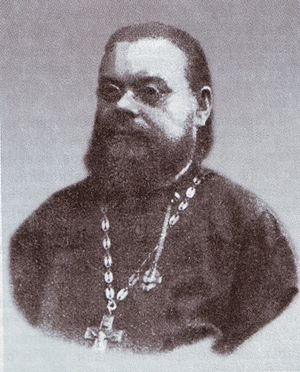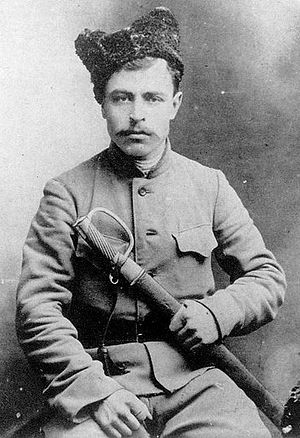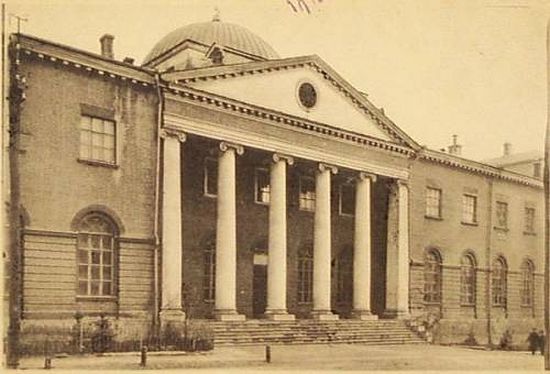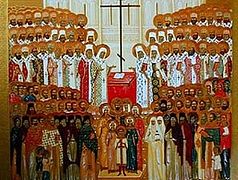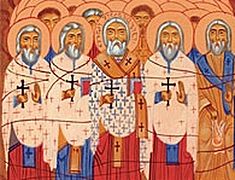On the ninety-fifth anniversary of the martyric death of the famous polemicist and professor of theology of the Imperial University of Kharkov.
In the kontakion to the New Martyrs and Confessors of Solovki, we sing, “Aflame with love for Christ, O martyrs, and having taken His cross upon your shoulders you have carried it, divinely enduring the cruelty of tortures in perfect humility…” Without a doubt, this applies also to all of the new martyrs, about whom it was rightly said: If all the Russian ascetics of the twentieth century are some day canonized, the Russian Orthodox Church would become a Church of Russian New Martyrs. There are persistent impressions that this is happening—although not all have been canonized.
***
The death of Fr. Nicholai is bound up with a critical moment in the Civil War, when the voluntary army of A. Denikin routed the soviet authorities from Kharkov, and the soviets took from Kharkov to Sumy hostages they had arrested during May and June of 1919. At the meeting of the Kharkov Soviet then was heard the words of the chief provincial chekist P. Kin: “In the event that the bourgeois vermin raise their heads, then the heads of the hostages will roll first.”
And the heads of the hostages rolled and rolled—at the hands of the commander of the special forces battalion, assistant to the chief of criminal investigation in Kharkov Province Executive Committee, S. Saenko, “a skinny man with the twitching face of a maniac and beady, darting eyes of a squirrel.” It was him, the uneducated carpenter Saenko, who “wrote the most sinister pages in the book of the Ukrainian terror.”
In the Kharkov prison, the name of Saenko alone brought mortal horror to the prisoners. It is difficult to convey an even approximate picture of his brutality (some of it was described and thus preserved for the prisoners’ descendants). We will limit ourselves to the fact that this monster left some of the corpses in such a shape that the doctors could not understand what Saenko had done to them.
This murderer lead a battalion made up of bandits who lived in Kharkov in the area of Ivanovka (a place that was known as a hotbed of criminality.) This gang of “special purpose”, which earned horrific notoriety not only in the Ukraine (even Batka Makhnoi was afraid of him), but throughout Russia, destroyed in this Sumy episode several dozen hostages—as early as July 2 they were alive and coerced into signing a collective letter to A. I. Denikin, which the Bolsheviks used as an instrument of pressure.
A report dated August 17, 1919 on the Bolshevik terror prepared by the department of propaganda of a special communiqué under commander A. Denikin states: An examination of the bodies of the Kharkov hostages found during grave excavations on a hill near the train station in Sumy showed that the majority died from saber wounds. Among these were discovered ten formless corpses with severed heads and extremities. Most likely one of these victims was Fr. Nicholai Strelletsky. Some sources suppose that the priest was executed in Orel, where the chekists intended to take the hostages. However, there is evidence that only five of the thirty-eight hostages made it to Orel, and they were women.
In his book, Dzerzhinsky, Roman Gul writes that as a result of his own savagery Saenko “lost his mind and his comrades ‘slapped’ [shot] him.” This is what happened according to Solzhenitsyn, Alexei Tolstoy, and the Russian historian, journalist, and public activist S. P. Melgunov, who was in exile from the country in 1922 with a large group of scientific intelligentsia, and was the author of the book, Red Terror in Russia: 1918-1923. However, after conducting archival research, the expert on Kharkov lore A. Zinukhov wrote in his article, “Commandant Saenko” (1994) that the pensioner of soviet directive Stepan Afanasievich Saenko died on August 17, 1973 in Kharkov at eighty-seven years of age.
What is the providential significance of the fact that torturer-executioners generally live long lives? There are not a few examples of this. Perhaps it is for their own torment, which a poet calls, “the snake gnawing at the heart”? In that case we can suppose that for the torturers this is that earthly hell—as a foretaste of eternal hell.
***
Having begun on that tragic note, recalling the terrible events in the Ukraine of ninety years ago, we give our due thanks to the memory of those murdered, and we are obligated to remember also the whole life’s path of this remarkable priest, his twenty-five years of the priesthood, his pastoral and pedagogical activities that on December 7, 1914 the Orthodox people of Kharkov celebrated; and this was in fact a notable event for the whole Church, in that N. S. Stellitsky’s theological works were well known throughout Russia.
At that time Fr. Nicholai was an archpriest of the Antoniev University church (during Soviet times, the “Youth” theatre occupied this building, and in more recent times, the Ukrainian cultural center). After the celebration the archpriest was presented with an icon of St. Nicholas the Wonder-Worker and a commemorative speech. Archbishop Anthony Khrapovitsky and member of the State Council and history professor D. I. Bagalei participated in the service and celebration, along with a multitude of other people.
By that time Fr. Nicholai was already a famous Orthodox theologian, awarded by the Tsar in 1908 with the Order of St. Anna, 3rd degree, and in 1912, with the 4th degree.
Nicholai Semenovich Stelletsky was born in 1862 near Kharkov, in the village of Muraf, Bogodukhov county, to the family of a priest. After graduating from the Kharkov theological seminary he completed the Kiev theological academy (1888) as a masters candidate of theology, where he was left to prepare for the professorial vocation. Having received ordination into the priesthood, he began his pastoral service in the Kiev Riverside St. Nicholas Church. At the same time, he served as a teacher of the Law of God in Kiev high schools, and as inspector of the periodical, Southwest School.
Having defended his master’s dissertation in 1893, he served in the St. Sophia Cathedral in Kiev.
In 1909 he was chosen as professor and head of the theology department in the Kharkov University, and at the same time was appointed archpriest of the Antoniev University church. He also bore the sizeable load of theology professor in the Kharkov Higher Courses for women, the Higher Medical Courses for women, the Higher commercial courses for the Kharkov merchants’ society, and served as president of the council for the Kharkov diocesan women’s school.
***
As a doctor of theology since 1914, a “true laborer of scholarship”, over his thirty years of pastoral activity Prof. N. S. Stelletsky published over forty works on moral theology, Church history in the Ukraine, philosophy, literary history, social-philosophical trends of the early twentieth century, and spiritual education.
Fr. Nicholai summed up his theological and intellectual work in a massive three-volume publication entitled Experience of Moral Orthodox Theology in Apologetic Interpretation. The first two volumes were published in 1914 and 1916 respectively, but the third volume’s publication was hindered by the events of 1917.
Over the course of twenty-five years, Fr. Nicholai published his treatises as separate publications and as articles in the periodical, Faith and Reason, which circulated for thirty years in Kharkov, and which presented articles by some of the greatest religious thinkers of Russia. In 1892, Fr. Nicholai’s article on the wonder-working Kaplunov icon of the Mother of God was published in part in this periodical. This icon played an important role in the battle of Poltava, when it was brought to the battlefield at Peter the Great’s behest. That year was the celebration of 305 years since the Poltava victory for Russia on the day of St. Sampson the Hospitable, June 27 (O.S.), 1709.
Fr. Nicholai also wrote an article about Gregory Skovorod (“The wandering Ukrainian philosopher Grigory Savich Skovorod”, 1894), and his thoughts on “the significance of Kiev as the religious center of Orthodox Russia,” in which he wrote: “Having served as the cradle of all Russian governmental life, Kiev became at the same time the cradle of the Orthodox Christian faith; it became, in the words of Metropolitan Sylvester, as if ‘our Russian heaven’, or, in the words of Emperor Alexander Nicholaevich, the ‘Jerusalem of the Russian land.’”
In this work, Fr. Nicholai cited the lyrical words of the Little Russian [Ukrainian] poet and writer Evgeny Grebinki (the poet who translated Pushkin’s “Poltava” into Ukrainian): “As the sun amidst the planets, as the tsar amidst the people, so is Kiev amidst the cities of Russia. It stands upon a high hill, girded about with geen orchards, crowned with the golden cupolas and crosses of churches. Beneath the hill run the lively waves of the mother Dniepr. Kiev, and the Dnieper, together… My God, what richness! Do you hear, good people? I am speaking to you of Kiev; and you do not weep from joy? Truly, you must not be Russian.”
These golden words about Russian values, literally picked up from the poet Grebinki (1812-1842), following Gogol with his Troika-bird and Taras Bulba, were cast into the twentieth century by Archpriest Stelletsky.
Now a century has passed, and it would be good for us [Russians and Ukrainians] to repeat them until they become once more the essence of those who live in Little Russia—that is, until they regain the understanding that they are not the result of plans devised by nineteenth century Austro-Hungarian intelligence agents, not the inheritors of Nazi punitive squads, not the product of orange-revolutionaries, but the people of Rus’.
Fr. Nicholai also wrote in this regard the work, “Gogol’s Religious-Moral world-view” (1902).
In 1911, he published an unexpected article entitled, “The history and critical evaluation of the duel from a scholarly-theological point of view,” in which he proved that the duel is a leftover of pagan times, and honor can never be defended by lethal weapons.
Titles of other articles speak eloquently of the theologian himself: “Contemporary decadence and Christianity (1909), “Socialism: its history and a critical evaluation from the Christian point of view” (1905), and “Modern socialism and Christianity” (1912).
In his works on socialism, in confirmation of patristic thought on Christianity that the reason for government is the “sinful corruption of people, which makes community life impossible without the force of law”, recognizing and commenting in detail on the need for serious social reform in Russian society, the theologian Stelletsky remained in his staunch position on communism, and considered that the time had come to “energetically struggle against this evil, which has poured over our society in a broad wave,” because there is an obvious utopian quality in the idea of “true equal rights for all people and in every aspect”.
Alas, Russian society did not heed the remarkable clairvoyance and warning of Fr. Nicholai (and not only of him), and therefore underwent the onerous punishments of the twentieth century.
The theological works, the life’s path, and terrible death of this guardian of Russian Orthodoxy from Kharkov, Fr. Nicholai Stelletsky, must not be forgotten in our [Russian, Ukrainian] homeland. Although it be a century later, we should heed the epistle of our remarkable countryman.

